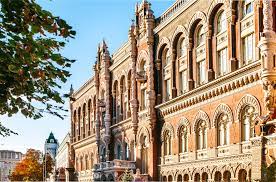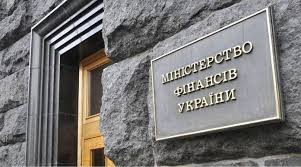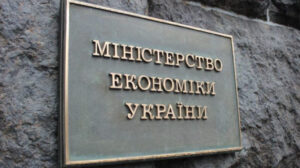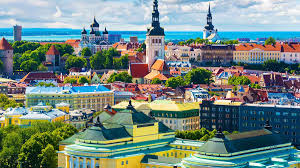
The National Bank of Ukraine has estimated Ukraine’s real gross domestic product (GDP) growth in the first quarter of 2024 by the same period last year at 3.1%, while in January it forecast it at 7.1%.
“Real GDP growth in the first quarter of 2024, according to NBU estimates, was weaker than expected, primarily due to restrained budget expenditures amid uncertainty about the receipt of external financing. An additional factor was the blockade of the western border, which restrained the activity of certain types of activities,” the National Bank explained in the Inflation Report published on its website.
At the same time, as the NBU pointed out, stable operation of the sea corridor, favorable weather and increased domestic demand supported economic growth. The central bank added that fiscal policy remained accommodative and, together with the effect of a significant increase in fiscal spending at the end of 2023, significantly fueled aggregate demand.
Earlier, in late April, the Economy Ministry estimated Ukraine’s GDP growth at 4.5% in the first quarter of this year.
As the National Bank notes, moderate GDP growth rates will remain until the end of 2024. “The main factors of growth will remain the preservation of soft fiscal policy, revitalization of external demand, as well as further adjustment of business and population to the conditions of significant security threats. However, the pace of economic growth will slow given the impact of the war and the depletion of growth momentum from the low base of 2022,” the NBI pointed out.
It added that the recovery will also be constrained by the impact of the destruction of energy infrastructure.
According to the updated forecasts, GDP growth will accelerate to 3.7% in the second quarter (the NBU expected it at 4.8% in January) before slowing to 1.3% (1.7%) in the third quarter and accelerating again to 4.1% (2.0%) in the fourth quarter.
Overall, for 2024, the NBU worsened its growth forecast for the Ukrainian economy to 3% from 3.6% in its January report, and for 2025 to 5.3% from 5.8%.
“The negative contribution of revised estimates of the e/e deficit to the change in real GDP in 2024 is estimated at 0.6 percentage points (pp), and 0.5 pp in 2025. Instead, the impact on GDP of a smaller grain harvest in 2024 will be insignificant due to the reorientation of agricultural producers to more marginal crops, particularly oilseeds,” the central bank said.
According to the regulator, the balance of risks of the baseline forecast is shifted towards deterioration of Ukraine’s economic growth rates and increased price pressure.
The National Bank in the updated Inflation Report increased the number of key risks of the forecast (with a strong impact and probability of 25-50%) to three: to the risk of a longer period and intensity of the war added the risk of large budgetary needs (a quarter earlier the NBU estimated its probability at 15-25%) and large damage to energy and port infrastructure (a quarter earlier the impact of this risk the central bank considered moderate).
At the same time, the probability of the risk of reduction of volumes and loss of rhythm of international aid receipts and continuation of partial blocking of cargo traffic across the border by some EU countries was reduced from 25-50% to 15-25%, but the degree of impact of the latter risk was increased from weak to moderate.
In addition, the NBU added a new risk – aggravation of the situation in the Red Sea, but estimated its probability at 15-25% and the degree of influence as low, as well as excluded the risk of increasing the capacity of maritime export routes, which is positive for the forecast.
Earlier Experts Club analytical center and Maxim Urakin released a video analysis of how the GDP of the world’s countries has changed in recent years, more detailed video analysis is available here – https://youtu.be/w5fF_GYyrIc?si=BsZmIUERHSBJrO_3 Subscribe to Experts Club YouTube channel here – https://www.youtube.com/@ExpertsClub.
EXPERTS CLUB, GDP, MACROECONOMICS, NATIONAL BANK, UKRAINE, URAKIN

Receipts of taxes, fees and mandatory payments to the general fund of the state budget of Ukraine, according to operational data, in April amounted to UAH 153.6 billion compared to UAH 164.3 billion in March and UAH 184.8 billion in February, such operational data (as of 16:00 on April 30) reported the Ministry of Finance on Tuesday.
According to its data, the most of all reduced receipts of payments from the State Tax Service – to 59.7 billion UAH from 105.7 billion UAH in March and 107.4 billion UAH in February, which is due to high payments in previous months of income tax, in particular, by banks, as well as advance payments.
It is pointed out that in April, income tax revenues amounted to only UAH 3.2 billion against UAH 60.1 billion in March and UAH 61.0 billion in February, but in April, part of its profit of UAH 38.64 billion was transferred to the budget by the National Bank, although the Ministry of Finance does not mention it in the summary.
As for other taxes, personal income tax and military levy increased to UAH 16.5 billion (UAH 15.7 billion) in April, rents to UAH 5.5 billion (UAH 1.4 billion), and excise tax to UAH 11.5 billion (UAH 9.2 billion).
Value added tax also increased to UAH 22.8 billion (UAH 18.0 billion): collected UAH 34.8 billion (UAH 29.0 billion), refunded – UAH 12.0 billion (UAH 11.1 billion).
Receipts from the State Customs Service increased in April to UAH 48.9 billion from UAH 45.8 billion in March and UAH 39.8 billion in February. As the head of the specialized parliamentary committee, Daniil Getmantsev, pointed out on Tuesday, about 2.5 billion hryvnias of additional revenue came from the unblocking of the Polish border over the past week.
The Finance Ministry pointed out that the monthly revenue estimate of the general fund of the state budget, according to operational data, was exceeded by 29.5% (+35 billion UAH), including by the State Tax Service – by 7.9% (+4.4 billion UAH), while the State Customs Service – by 14.5% (+6.2 billion UAH).
In addition, the general fund of the state budget received UAH 2.7 billion of international aid in the form of grants in April, compared to UAH 3.1 billion in March and UAH 31 billion in February.
“In general, according to operational data, at the end of April 2024, the general and special funds of the state budget received UAH 200.8 billion (UAH 225.9 billion in March and UAH 229.0 billion in February) of taxes, fees and other payments. In addition, about UAH 40.1 billion (in March – UAH 39.0 billion) in the form of ERUs was received by the Pension Fund and social insurance funds,” the ministry added, thanking taxpayers for your contribution to the support of the Ukrainian army and financial stability of the country.
Data on expenditures in April are not yet available.
As reported, the Verkhovna Rada adopted the state budget for 2024 with a deficit of UAH 1.57 trillion, or 20.6% of projected GDP. Revenues of the state budget-2024 are set at UAH 1.77 trillion (not taking into account possible grant aid), expenditures – UAH 3.36 trillion at an average annual exchange rate of UAH 40.7/$1.
State budget-2023 revenues amounted to UAH 2.67 trillion, of which grant aid amounted to UAH 0.43 trillion. Cash expenditures of the state budget for the past year exceeded UAH 4 trillion, and the deficit amounted to UAH 1.33 trillion at an average annual exchange rate of about 36.6 UAH/$1.
Earlier Experts Club analytical center and Maxim Urakin released a video analysis of how the GDP of the world’s countries has changed in recent years, more detailed video analysis is available here – https://youtu.be/w5fF_GYyrIc?si=BsZmIUERHSBJrO_3 Subscribe to Experts Club YouTube channel here – https://www.youtube.com/@ExpertsClub.
BUDGET, decreased in April, EXPERTS CLUB, GDP, MACROECONOMICS, MINISTRY OF FINANCE, TAXES, UKRAINE, URAKIN

Ukraine’s real gross domestic product (GDP) growth for January-March 2024 amounted to 4.5% (+/- 1%) from 3.6% (+/- 1%) at the end of January-February.
Growth accelerated to 4.6% (+/- 1%) in March from 3.9% (+/- 1%) in February and 3.5% (+/- 1%) in January this year, according to an estimate released on the website of the Ministry of Economy of Ukraine.
“In March 2024, the trend of recovery growth continued, supported by the stable operation of the Ukrainian maritime corridor (stimulated activity in rail transport, metallurgy and metal ore mining), increased production capacity in the extractive industry, intensified production of mineral fertilizers, increased demand for construction materials, taking place against the backdrop of improved business sentiment … and revival of consumer activity …,” the Ministry of Economy pointed out.
The Ministry added that in March, almost all aggregated economic activities formed a positive contribution to the total GDP. Thus, exports of products of agricultural production and mining and metallurgical complex were provided by the Ukrainian Sea Corridor; and investment demand generated by the budget, as well as the increase in production capacity in the extractive industry formed a positive contribution of production types.
At the same time, it is pointed out that the dynamics of electricity production slowed down significantly in the context of significant rocket attacks in late March, which led to serious damage to energy infrastructure and will require a significant period of time and resources to restore it.
As reported, the National Bank of Ukraine on April 25 worsened its forecast for the country’s GDP growth this year from 3.6% to 3% after 5.3% last year.
When approving the draft state budget for the second reading in early November 2023, the government forecasted GDP growth of 4.6% this year.
Earlier Experts Club analytical center and Maxim Urakin released a video analysis of how the GDP of the world’s countries has changed in recent years, more detailed video analysis is available here – https://youtu.be/w5fF_GYyrIc?si=BsZmIUERHSBJrO_3 Subscribe to Experts Club youtube channel here – https://www.youtube.com/@ExpertsClub
EXPERTS CLUB, GDP, MACROECONOMICS, MINISTRY OF ECONOMY, UKRAINE, УРАКІНА

The National Bank of Ukraine has raised its forecast of international reserves to $43.4 billion at the end of this year from $40.4 billion and to $44.3 billion at the end of next year from $42.1 billion.
“Compared to the previous forecast, the risk of insufficient international financing this year has significantly weakened, but the risks of rhythmicity of its receipt remain,” the NBU said in a press release on Thursday.
The central bank reminded that in March, about $9 billion was received from international partners, which allowed to increase international reserves to almost $44 billion.
In addition, in recent days, Ukraine has received positive news from the United States about the approval of a military and financial assistance package, and another tranche of EUR 1.5 billion has been received from the EU.
“In view of this, Ukraine can count on $38 billion of external budgetary assistance this year,” the NBU said.
According to its updated forecast, the estimate of the current account deficit this year has been downgraded from $16.9 billion to $20.2 billion, but next year it has been improved from $19.8 billion to $18.2 billion.
For more details on macroeconomic indicators of Ukraine and the world, GDP of major countries and other economic topics, please see one of the video analyzes of the Experts club think tank – https://youtu.be/w5fF_GYyrIc?si=Ymo-FlMFNGfLLdK-
You can subscribe to the Experts club channel here: https://www.youtube.com/@ExpertsClub
EXPERTS CLUB, GDP, international reserve, MACROECONOMICS, NATIONAL BANK

Ukraine’s real gross domestic product (GDP) year-on-year growth in March 2024 was 4.9%, compared to 5.0% in February and 5.2% in January, according to the Institute for Economic Research and Policy Consulting (IEPC) Monthly Economic Monitor.
“Businesses faced restrictions on electricity supply as a result of Russian shelling of energy facilities. This has held back GDP growth. In April, we also expect GDP growth to slow down due to problems with access to electricity due to massive generation destruction,” said Alexandra Betlij, a leading researcher at the IEI.
The institute estimates that real gross value added (GVA) growth in the processing industry, slowed to almost 11% in March, down from 17% in January, while real GVA in electricity generation declined by 2% and is expected to fall further in April.
It is pointed out that real GVA in transportation continued to grow by more than 20%. Growth was also maintained in construction, particularly due to the construction of budget-financed fortifications, while growth in trade slowed to 4.6%.
Among the main macroeconomic trends last month, IED experts additionally highlighted the increase in transportation by Ukrzaliznytsia and through the Ukrainian Sea Corridor, which contributes to the development of a number of sectors of the economy, record external financing in the amount of $9 bln, a decrease in inflation to 3.2% and the discount rate to 14.5%, as well as the weakening of the hryvnia to 39 UAH/$1 on the background of restrained interventions by the NBU
It is also noted that the value of merchandise exports fell sharply in March this year compared to March last year amid continued decline in grain and iron ore prices.
As reported, after Ukraine’s GDP growth of 5.3% in 2023, the National Bank expects it to slow down this year to 3.6%, while the government – to 4.6%. According to the Ministry of Economy, GDP growth for January-February this year amounted to 3.6%, while the NBU in January forecast it in the first quarter at 7.1%.

The Estonian Ministry of Finance expects zero growth of the country’s economy at the end of the current year.
According to the forecast published by the Ministry, the reduction in external demand in the second half of last year was stronger than expected, and the expected turn to economic recovery did not take place. This will have the consequence of the lack of growth in the current year.
The Ministry of Economy notes that last year, the exchange of goods contracted globally, driven by the cooling of the Chinese economy and geopolitical tensions. In developed countries and Europe, this was compounded by the rapid rise in interest rates, which was launched to curb inflation, and the deterioration in capital- and energy-intensive activities due to the energy crisis.
Nevertheless, according to the Ministry’s assessment, the factors restraining the development of the Estonian economy have been receding in recent years: price growth has slowed down, wage growth has continued, interest rates have gradually decreased, and there is no high unemployment.
The Estonian Ministry of Finance prepares a financial and economic forecast twice a year, in spring and summer.
Estonia’s GDP in 2023 has decreased by 3.1%. At the end of March 2024, the Bank of Estonia gave a forecast that the country’s GDP decline would slow down to “minus” 0.6% this year and the economy would grow by 3.2% in 2025.
Earlier Experts Club think tank and Maxim Urakin released a video analysis of how the GDP of the world’s largest economies has changed over the past decades, more video analysis is available here –
https://youtu.be/w5fF_GYyrIc?si=BsZmIUERHSBJrO_3
Subscribe to Experts Club YouTube channel here – https://www.youtube.com/@ExpertsClub
ECONOMIC GROWTH, ESTONIA, EXPERTS CLUB, GDP, MACROECONOMICS, MINISTRY OF FINANCE, URAKIN